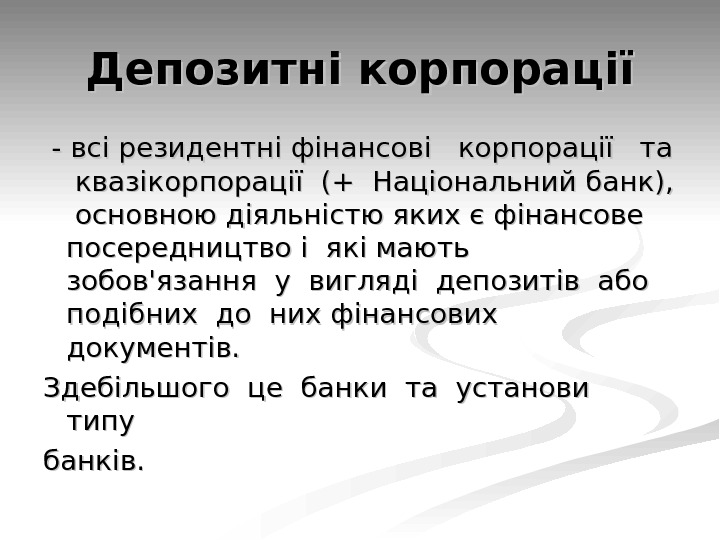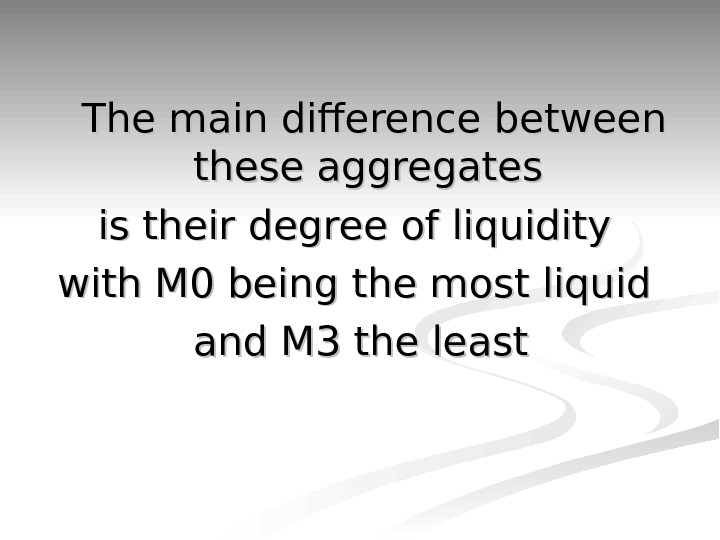Measuring Money 1. 1. Money aggregates 2.

















- Размер: 208.5 Кб
- Количество слайдов: 16
Описание презентации Measuring Money 1. 1. Money aggregates 2. по слайдам
 Measuring Money
Measuring Money
 1. 1. Money aggregates 2. 2. Deposit expansion multiplier 3. 3. Monetary base
1. 1. Money aggregates 2. 2. Deposit expansion multiplier 3. 3. Monetary base
 Money aggregates (( Fed’s methodology )) Money aggregate M 1 = Currency + Travelers’ Checks + Demand Deposits (Checking Accts No Interest) + Other Checkable Deposits (With Interest) M 2 = M 1 + Small-Denomination Time Deposits + Savings Deposits and money market + Retail Money Market Mutual Funds M 3 = M 2 + Large-Denomination Time Deposits + Institutional Money-Market Mutual Fund + Repurchase Aggrements + Eurodollars
Money aggregates (( Fed’s methodology )) Money aggregate M 1 = Currency + Travelers’ Checks + Demand Deposits (Checking Accts No Interest) + Other Checkable Deposits (With Interest) M 2 = M 1 + Small-Denomination Time Deposits + Savings Deposits and money market + Retail Money Market Mutual Funds M 3 = M 2 + Large-Denomination Time Deposits + Institutional Money-Market Mutual Fund + Repurchase Aggrements + Eurodollars
 A mutual fund is a professionally-managed type of collective investment scheme that pools money from many investors to buy securities (stocks, bonds, short-term money market instruments, and/or other securities). Eurodollars are time deposits denominated in U. S. dollars at banks outside the United States Eurocurrency is the term used to describe deposits residing in banks that are located outside the borders of the country that issues the currency the deposit is denominated in.
A mutual fund is a professionally-managed type of collective investment scheme that pools money from many investors to buy securities (stocks, bonds, short-term money market instruments, and/or other securities). Eurodollars are time deposits denominated in U. S. dollars at banks outside the United States Eurocurrency is the term used to describe deposits residing in banks that are located outside the borders of the country that issues the currency the deposit is denominated in.
 Грошові агрегати (звітність НБУ)
Грошові агрегати (звітність НБУ)
 ДД епозитні корпорації — всі резидентні фінансові корпорації та квазікорпорації (+ Національний банк), основною діяльністю яких є фінансове посередництво і які мають зобов’язання у вигляді депозитів або подібних до них фінансових документів. Здебільшого це банки та установи типу банків.
ДД епозитні корпорації — всі резидентні фінансові корпорації та квазікорпорації (+ Національний банк), основною діяльністю яких є фінансове посередництво і які мають зобов’язання у вигляді депозитів або подібних до них фінансових документів. Здебільшого це банки та установи типу банків.
 The main difference between these aggregates is their degree of liquidity with M 0 being the most liquid and M 3 the least
The main difference between these aggregates is their degree of liquidity with M 0 being the most liquid and M 3 the least
 Deposit Creation 1. The Fed buys $100, 000 worth of securities from a bank called First Bank. The purchase leaves the bank’s total assets unchanged, but it shifts $100, 000 out of securities and $100, 000 into reserves. Thus, if it does nothing the revenue stream for the bank will fall. With liabilities of the bank unaffected, the required reserves are also unchanged. So, the additional $100, 000 is all excess reserves.
Deposit Creation 1. The Fed buys $100, 000 worth of securities from a bank called First Bank. The purchase leaves the bank’s total assets unchanged, but it shifts $100, 000 out of securities and $100, 000 into reserves. Thus, if it does nothing the revenue stream for the bank will fall. With liabilities of the bank unaffected, the required reserves are also unchanged. So, the additional $100, 000 is all excess reserves.
 2. 2. Bank can lend out these excess reserves. Assume that First Bank receives a loan application for $100, 000. With these excess reserves, the bank can approve the loan and credit the companies checking account $100, 000. 3. 3. Now this new loan is not going to stay at First Bank. The company who needed the loan is going to withdraw the money to pay bills. So, in the end First Bank’s balance sheet is simply changed with an additional $100, 000 in Loans and a $100, 000 reduction in securities.
2. 2. Bank can lend out these excess reserves. Assume that First Bank receives a loan application for $100, 000. With these excess reserves, the bank can approve the loan and credit the companies checking account $100, 000. 3. 3. Now this new loan is not going to stay at First Bank. The company who needed the loan is going to withdraw the money to pay bills. So, in the end First Bank’s balance sheet is simply changed with an additional $100, 000 in Loans and a $100, 000 reduction in securities.
 4. 4. This $100, 000 was used to pay for steel at Steel Co. 55. Steel Co will then take this money and deposit it in their bank called Second Bank. So Second Bank has an additional $100, 000 in reserves and liabilities. Let’s assume that the Reserve Requirement is 10 % Reserve Requirement is a fraction of bank’s liabilities, which is to be held according to Central Bank’s demand to maintain the stability of banking system.
4. 4. This $100, 000 was used to pay for steel at Steel Co. 55. Steel Co will then take this money and deposit it in their bank called Second Bank. So Second Bank has an additional $100, 000 in reserves and liabilities. Let’s assume that the Reserve Requirement is 10 % Reserve Requirement is a fraction of bank’s liabilities, which is to be held according to Central Bank’s demand to maintain the stability of banking system.
 The required reserves of a bank can be expressed as a fraction of deposits. Required Reserves = Reserve Requirement ×Deposits RR = rd × × DD Any changes in deposits creates a corresponding change in reserves, ∆ ∆ RR = rd × ∆D∆
The required reserves of a bank can be expressed as a fraction of deposits. Required Reserves = Reserve Requirement ×Deposits RR = rd × × DD Any changes in deposits creates a corresponding change in reserves, ∆ ∆ RR = rd × ∆D∆
 6. 6. Given a reserve requirement of 10%, we know that for an additional $100, 000 in liabilities, Second Bank only needs an additional $10, 000 in reserve. So they have $90, 000 in excess reserves. 7. 7. Second Bank will issue an additional $90, 000 in loans. 8. 8. This new loan is deposited in another bank, Third Bank. The change in Third Bank is similar to that of Second Bank, only the additional liabilities are $90, 000 instead of $100, 000. RR equired r eserves of the Third Bank = = $9,
6. 6. Given a reserve requirement of 10%, we know that for an additional $100, 000 in liabilities, Second Bank only needs an additional $10, 000 in reserve. So they have $90, 000 in excess reserves. 7. 7. Second Bank will issue an additional $90, 000 in loans. 8. 8. This new loan is deposited in another bank, Third Bank. The change in Third Bank is similar to that of Second Bank, only the additional liabilities are $90, 000 instead of $100, 000. RR equired r eserves of the Third Bank = = $9,
 So the $100, 000 open market operation has created $100, 000 + $90, 000 = $190, 000 in new checking deposits and $100, 000 + $90, 000+ $81, 000 = $271, 000 in new loans at the three banks. This process continues to work its way through the system with each bank seeing a similar change in their balance sheet.
So the $100, 000 open market operation has created $100, 000 + $90, 000 = $190, 000 in new checking deposits and $100, 000 + $90, 000+ $81, 000 = $271, 000 in new loans at the three banks. This process continues to work its way through the system with each bank seeing a similar change in their balance sheet.
 MB = Cash + Bank Reserves Monetary Base
MB = Cash + Bank Reserves Monetary Base
 Let’s define the quantity of money as M, the monetary base as MB, and the money multiplier as m. M = m×MB M = Currency + Deposits MB = Currency + Reserves C – Currency R — Reserves R = RR + ER RR — Required Reserves ER — Excess Reserves
Let’s define the quantity of money as M, the monetary base as MB, and the money multiplier as m. M = m×MB M = Currency + Deposits MB = Currency + Reserves C – Currency R — Reserves R = RR + ER RR — Required Reserves ER — Excess Reserves


